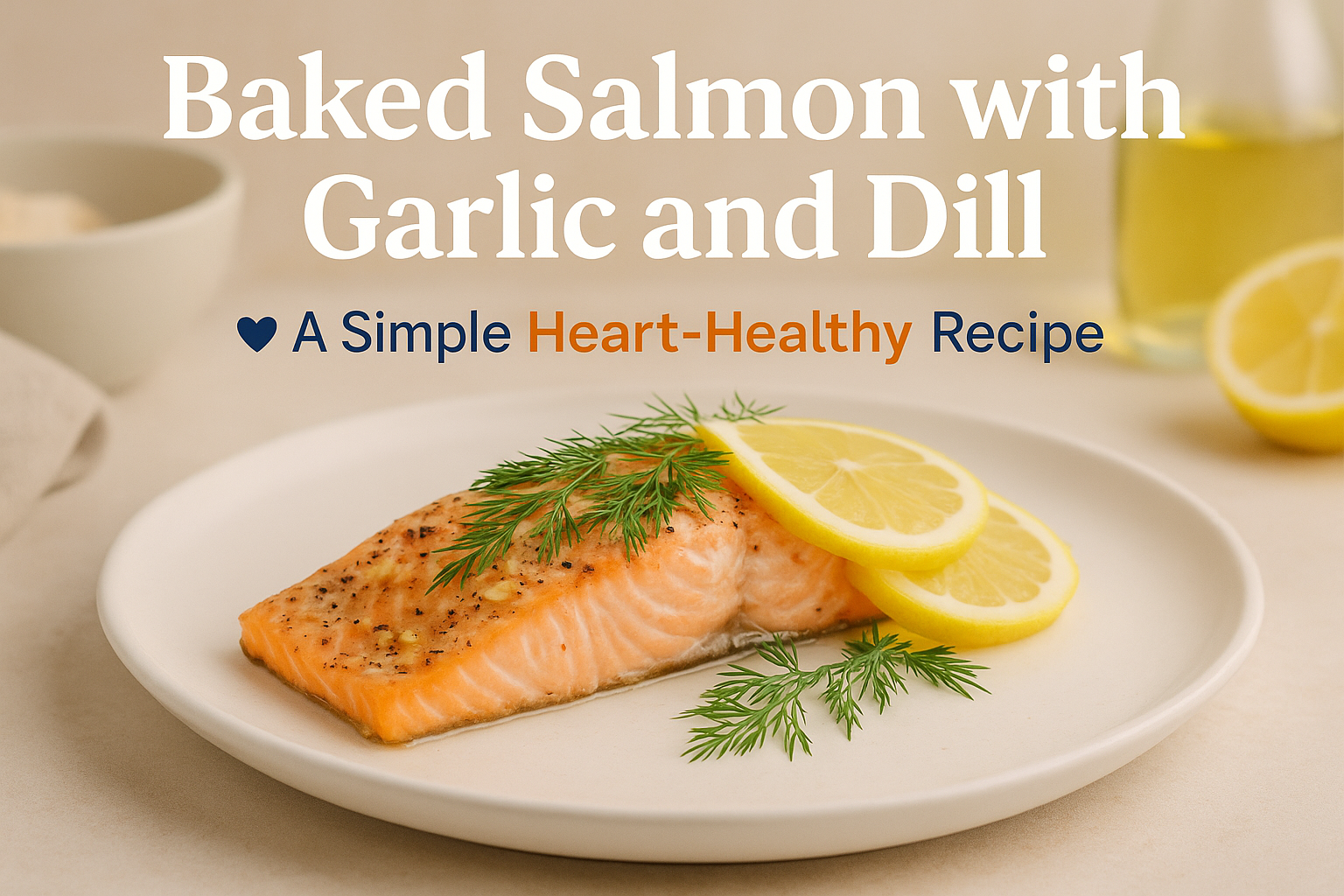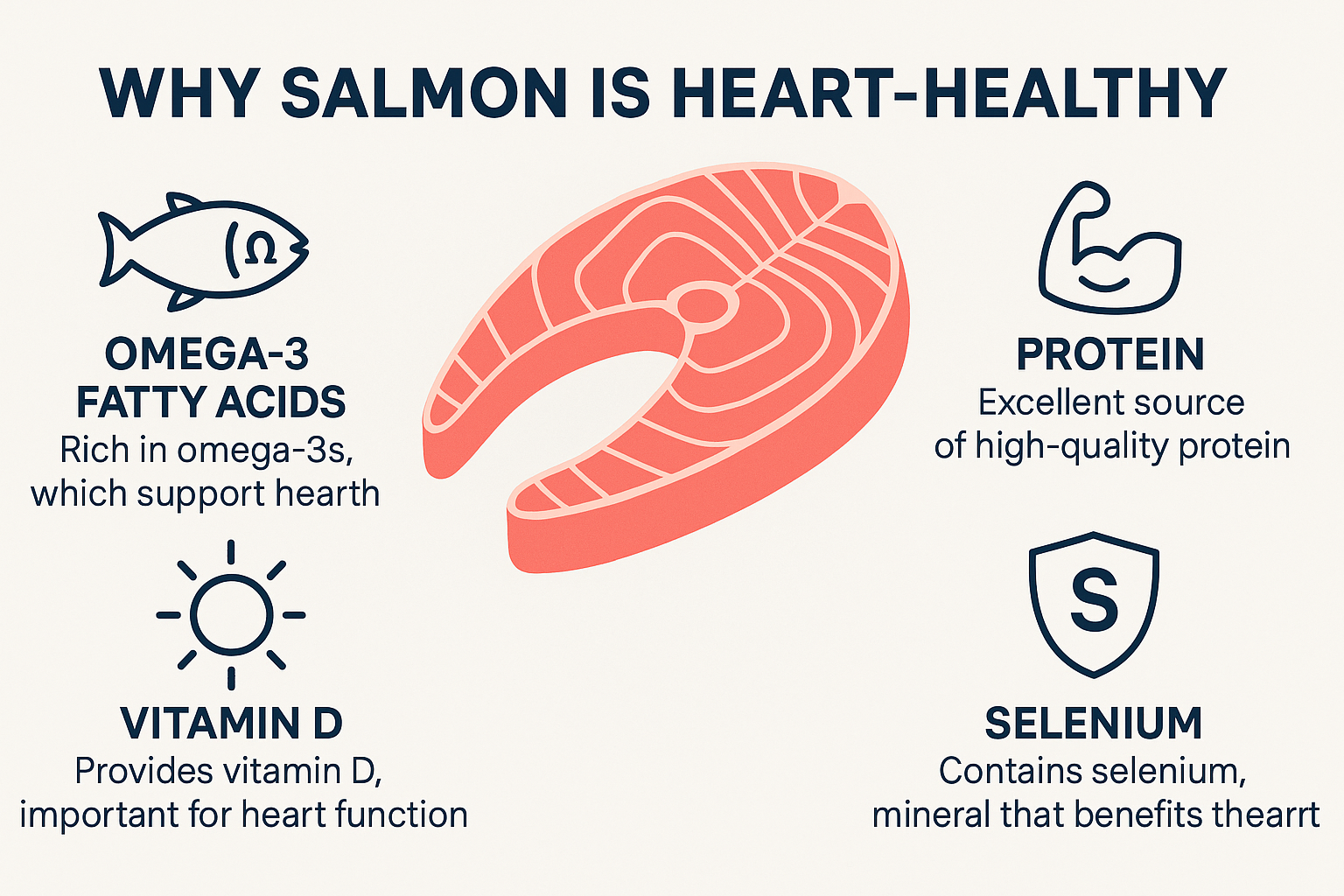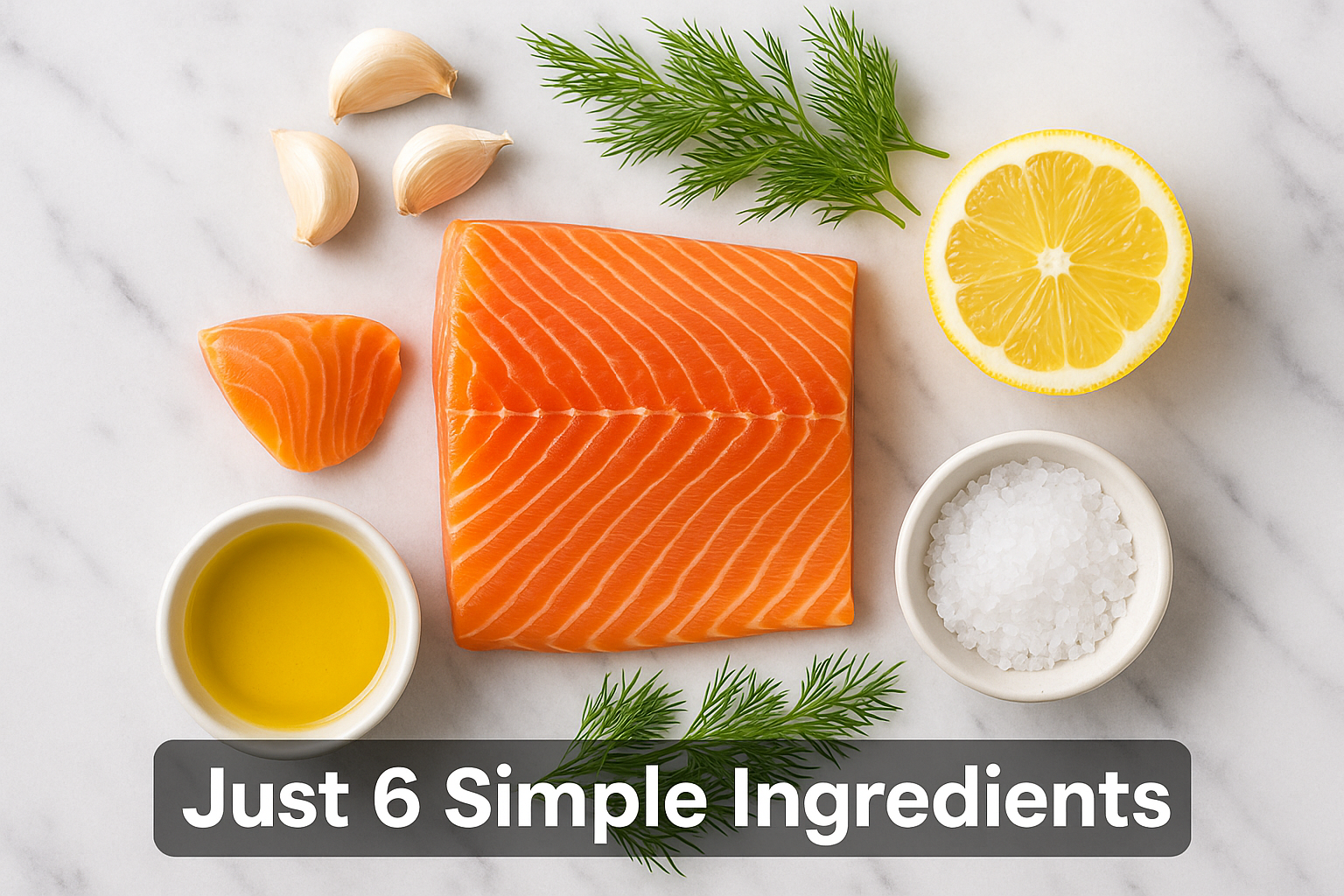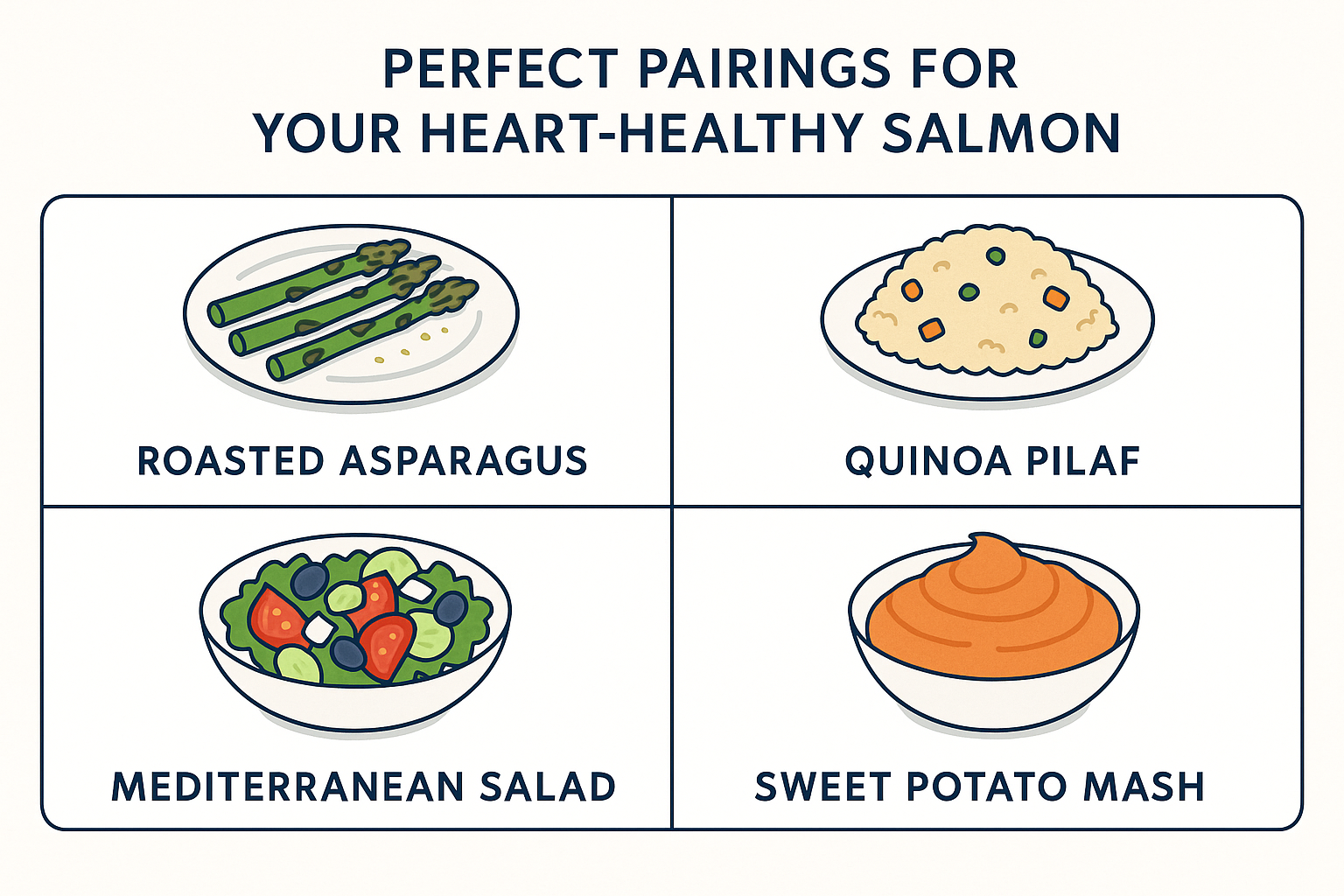Baked Salmon with Garlic and Dill – A Simple Heart-Healthy Recipe
Picture this: It’s a busy weeknight, your stomach is growling, and the last thing you want is to spend hours in the kitchen. What if we told you that in just 20 minutes, you could serve up a restaurant-quality meal that’s not only delicious but also incredibly good for your heart? Enter baked salmon with garlic and dill—a simple heart-healthy recipe that’s about to become your new go-to dinner solution.
This isn’t just another fish recipe. This is your ticket to better cardiovascular health, sustained energy levels, and a meal that’ll make your taste buds dance. Whether you’re looking to support your fitness goals alongside your arm toning workout or simply want to nourish your body with wholesome ingredients, this salmon dish delivers on every front. 🐟✨
Key Takeaways

Why Salmon is the Ultimate Heart-Healthy Protein
Before we dive into the recipe, let’s talk about why salmon deserves a starring role in your weekly meal rotation. This pink-fleshed fish isn’t just trendy—it’s backed by decades of nutritional science.
The Omega-3 Advantage
Salmon is loaded with omega-3 fatty acids, particularly EPA and DHA, which are essential for heart health. These healthy fats work like tiny maintenance crews in your cardiovascular system, helping to:
According to the American Heart Association, eating at least two servings of fatty fish per week can significantly reduce your risk of heart disease and stroke. That’s powerful medicine on a plate! 💪
Protein That Powers Your Workouts
If you’re incorporating an arm toning workout or dumbbell shoulder exercises into your fitness routine, salmon provides the high-quality protein your muscles need to recover and grow stronger. A 4-ounce serving delivers approximately 25 grams of complete protein, containing all nine essential amino acids.
This makes it an ideal post-workout meal that supports upper body strength development while keeping your heart healthy—a win-win combination that’s hard to beat.
Nutrient Density Beyond Compare
Beyond omega-3s and protein, salmon is packed with:
| Nutrient | Benefit |
|———-|———|
| Vitamin D | Supports bone health and immune function |
| Vitamin B12 | Essential for energy production and nerve health |
| Selenium | Powerful antioxidant that protects cells |
| Potassium | Helps regulate blood pressure |
| Astaxanthin | Anti-inflammatory antioxidant that gives salmon its pink color |
The Magic of Garlic and Dill
While salmon is the star of this simple heart-healthy recipe, the supporting cast of garlic and dill brings both flavor and additional health benefits to the table.
Garlic: Nature’s Cardiovascular Protector
Garlic has been used medicinally for thousands of years, and modern science confirms what ancient healers knew: this pungent bulb is a heart-health champion. Here’s what garlic brings to your salmon:
Dill: The Underrated Herb
Fresh dill isn’t just a pretty garnish—it’s a nutritional powerhouse that perfectly complements salmon’s rich flavor. Dill offers:
The combination of salmon, garlic, and dill creates a simple heart-healthy recipe that’s greater than the sum of its parts. 🌿
The Complete Recipe: Baked Salmon with Garlic and Dill
Now let’s get to what you came here for—the actual recipe! This simple heart-healthy recipe requires minimal ingredients and even less effort.
Ingredients (Serves 4)
For the Salmon:
Optional Additions:
Equipment Needed
Step-by-Step Instructions
Step 1: Prepare Your Oven and Baking Sheet
Preheat your oven to 400°F (200°C). Line your baking sheet with parchment paper or lightly grease it with olive oil. This prevents sticking and makes cleanup a breeze.
Step 2: Prepare the Salmon
Pat the salmon fillets dry with paper towels. This step is crucial—moisture on the surface prevents proper browning and can make your salmon steamed rather than baked. Place the fillets skin-side down on your prepared baking sheet, spacing them about 2 inches apart.
Step 3: Make the Garlic-Dill Mixture
In a small bowl, combine:
Mix well until you have a fragrant, herb-infused oil. This is where the magic happens! ✨
Step 4: Season the Salmon
Generously brush or spoon the garlic-dill mixture over each salmon fillet, making sure to coat the top and sides. Don’t be shy—this is where all the flavor comes from in this simple heart-healthy recipe.
Step 5: Bake to Perfection
Place the baking sheet in your preheated oven and bake for 12-15 minutes, depending on thickness. The salmon is done when:
Pro Tip: Don’t overcook your salmon! It will continue cooking slightly after you remove it from the oven. Slightly undercooked is better than dry and overcooked.
Step 6: Rest and Serve
Let the salmon rest for 2-3 minutes after removing it from the oven. This allows the juices to redistribute throughout the fish. Garnish with additional fresh dill and lemon wedges before serving.
Perfect Pairings: What to Serve with Your Salmon

A simple heart-healthy recipe deserves equally nutritious side dishes. Here are some excellent pairings that complement the flavors while keeping your meal balanced:
Vegetable Sides
Roasted Asparagus 🥬
Toss asparagus spears with olive oil, salt, and pepper. Roast alongside your salmon for the last 10 minutes of cooking time.
Steamed Broccoli
Simple, nutritious, and ready in minutes. Add a squeeze of lemon to tie the flavors together.
Mediterranean Salad
Combine mixed greens, cherry tomatoes, cucumber, red onion, and olives with a light lemon vinaigrette.
Sautéed Green Beans
Quick-cook green beans with garlic and a touch of butter or olive oil.
Healthy Carbohydrates
Quinoa Pilaf
This complete protein grain adds substance without weighing you down. Cook with vegetable broth for extra flavor.
Sweet Potato Mash
Rich in fiber and vitamins, sweet potatoes provide sustained energy—perfect if you’re planning an arm toning workout later.
Wild Rice
Nutty and chewy, wild rice pairs beautifully with salmon’s rich flavor.
Cauliflower Rice
For a low-carb option, pulse cauliflower florets in a food processor and sauté with garlic.
Nutritional Breakdown: Why This Recipe Works
Let’s look at the numbers behind this simple heart-healthy recipe. Understanding the nutritional profile helps you appreciate just how beneficial this meal is for your body.
Per Serving (One 6-oz Salmon Fillet with Topping)
| Nutrient | Amount | % Daily Value |
|———-|——–|—————|
| Calories | 340 | 17% |
| Protein | 34g | 68% |
| Total Fat | 22g | 28% |
| Saturated Fat | 3.5g | 18% |
| Omega-3 Fatty Acids | 2.5g | – |
| Cholesterol | 95mg | 32% |
| Sodium | 180mg | 8% |
| Carbohydrates | 2g | 1% |
| Fiber | 0g | 0% |
| Sugar | 0g | 0% |
What These Numbers Mean for Your Health
High Protein, Moderate Fat: This macronutrient profile supports muscle recovery after dumbbell shoulder exercises while providing satiety that lasts for hours.
Omega-3 Rich: With 2.5 grams of omega-3s per serving, you’re meeting or exceeding the American Heart Association’s recommendations in a single meal.
Low Sodium: Unlike many restaurant meals, this recipe keeps sodium in check, which is crucial for maintaining healthy blood pressure.
Minimal Carbohydrates: The low carb count makes this suitable for various eating styles, from keto to paleo to Mediterranean diets.
Customization Options for Every Dietary Need
One of the best things about this simple heart-healthy recipe is its versatility. Here’s how to adapt it to different dietary preferences and restrictions:
For Keto Dieters
The base recipe is already keto-friendly! Pair it with:
For Paleo Followers
This recipe fits perfectly into a paleo lifestyle. Just ensure your salmon is wild-caught and pair with:
For Low-FODMAP Diets
Replace garlic with garlic-infused olive oil (the oil captures flavor without the FODMAPs). All other ingredients are naturally low-FODMAP.
For Whole30 Compliance
Skip the honey in the optional additions, and you’re good to go! This recipe aligns perfectly with Whole30 principles.
For Dairy-Free Needs
Great news—this recipe is naturally dairy-free! No modifications needed.
Meal Prep Magic: Making This Recipe Work for Your Week
Busy schedules don’t have to derail your healthy eating goals. This simple heart-healthy recipe is perfect for meal prep. Here’s how to make it work:
Batch Cooking Strategy
Sunday Prep Session:
Storage Tips
Refrigeration: Store cooked salmon in airtight containers for 3-4 days. Keep the garlic-dill topping separate if possible to maintain freshness.
Freezing: While fresh is best, you can freeze cooked salmon for up to 3 months. Thaw overnight in the refrigerator before reheating.
Reheating: Gently reheat in a 275°F oven for 10-12 minutes, or microwave on 50% power to prevent drying out.
Pre-Workout and Post-Workout Timing
If you’re incorporating this meal around your upper body strength training:
Pre-Workout (2-3 hours before): Pair salmon with complex carbs like quinoa or sweet potato for sustained energy.
Post-Workout (within 2 hours): The high-quality protein supports muscle recovery after arm toning workout sessions or dumbbell shoulder exercises.
Common Mistakes to Avoid

Even with a simple heart-healthy recipe, there are a few pitfalls that can affect your results. Here’s what to watch out for:
Overcooking the Salmon ❌
The Problem: Dry, chalky salmon that’s lost all its moisture and flavor.
The Solution: Use an instant-read thermometer and remove salmon at 140-145°F. Remember, it continues cooking after removal from heat.
Using Low-Quality Salmon
The Problem: Farmed salmon raised with antibiotics and fed artificial colorants.
The Solution: Choose wild-caught Alaskan salmon when possible. Look for certifications like MSC (Marine Stewardship Council) or ASC (Aquaculture Stewardship Council).
Skipping the Pat-Dry Step
The Problem: Steamed rather than baked salmon with no caramelization.
The Solution: Always pat your salmon completely dry before seasoning. This simple step makes a huge difference in texture.
Not Letting Garlic Bloom
The Problem: Raw, harsh garlic flavor that overwhelms the dish.
The Solution: If you’re sensitive to raw garlic, briefly sauté the minced garlic in olive oil before mixing with dill. This mellows the flavor while maintaining health benefits.
Forgetting to Check for Bones
The Problem: Biting into an unexpected pin bone mid-meal.
The Solution: Run your fingers along the fillet before cooking. Use tweezers or needle-nose pliers to remove any pin bones you find.
The Science Behind Heart-Healthy Eating
Understanding why this simple heart-healthy recipe works helps reinforce your commitment to nutritious eating. Let’s explore the cardiovascular science:
How Omega-3s Protect Your Heart
Omega-3 fatty acids work through multiple mechanisms:
The Mediterranean Diet Connection
This salmon recipe embodies principles of the Mediterranean diet, which has been extensively studied for cardiovascular benefits. Key elements include:
Research published in the New England Journal of Medicine found that Mediterranean-style eating reduced major cardiovascular events by 30% compared to low-fat diets.
Beyond Heart Health: Additional Benefits
While cardiovascular protection is the star attraction, this simple heart-healthy recipe offers numerous other health advantages:
Brain Function and Mental Clarity 🧠
The DHA in salmon is a primary structural component of brain tissue. Regular consumption supports:
Anti-Inflammatory Benefits
Chronic inflammation underlies many modern diseases. The omega-3s, garlic, and dill in this recipe all possess anti-inflammatory properties that may help with:
Skin Health and Appearance
Omega-3s support skin health from the inside out:
Weight Management
Despite being relatively calorie-dense, salmon supports healthy weight management through:
Seasonal Variations and Flavor Twists
Once you’ve mastered the basic simple heart-healthy recipe, try these delicious variations to keep things interesting:
Spring Version: Lemon-Herb Salmon
Add to the basic recipe:
Summer Version: Mediterranean Salmon
Top with:
Fall Version: Maple-Mustard Salmon
Create a glaze with:
Winter Version: Citrus-Ginger Salmon
Swap lemon for:
Sustainability Considerations

Choosing sustainable seafood ensures this simple heart-healthy recipe is good for the planet as well as your body.
What to Look For
Wild-Caught Alaskan Salmon: Generally the most sustainable option, with well-managed fisheries.
Certifications to Trust:
Species Considerations: Sockeye, coho, and pink salmon from Alaska are typically the most sustainable choices.
Avoiding Overfished Options
Check resources like the Monterey Bay Aquarium’s Seafood Watch program for current recommendations. They provide region-specific guidance on which salmon to choose and which to avoid.
Frequently Asked Questions
Q: Can I use frozen salmon for this recipe?
A: Absolutely! Thaw it completely in the refrigerator overnight, then pat very dry before proceeding with the recipe.
Q: How do I know when my salmon is done?
A: The internal temperature should reach 145°F, and the flesh should flake easily with a fork while remaining slightly translucent in the very center.
Q: Can I make this recipe without fresh dill?
A: Yes, use 1 tablespoon of dried dill instead of 3 tablespoons fresh. Other herbs like parsley, basil, or tarragon also work well.
Q: Is salmon skin healthy to eat?
A: Yes! Salmon skin contains omega-3s and collagen. If you enjoy the crispy texture, it’s perfectly healthy to consume.
Q: How often should I eat salmon for heart health?
A: The American Heart Association recommends at least two 3.5-ounce servings of fatty fish per week.
Q: Will this recipe work with other types of fish?
A: Definitely! Try it with arctic char, trout, or even cod, adjusting cooking time based on thickness.
Building a Heart-Healthy Lifestyle Beyond This Recipe
This simple heart-healthy recipe is just one piece of your wellness puzzle. Here’s how to build a comprehensive approach:
Complement Your Nutrition with Movement
Pair your heart-healthy eating with regular exercise:
Stress Management Matters
Chronic stress negatively impacts heart health. Incorporate:
Regular Health Monitoring
Stay on top of your cardiovascular health with:
Conclusion: Your Path to Heart Health Starts Here
Creating a simple heart-healthy recipe like this baked salmon with garlic and dill isn’t just about one meal—it’s about establishing patterns that support lifelong wellness. With just 20 minutes of active time and six basic ingredients, you can nourish your body with omega-3-rich protein, anti-inflammatory compounds, and delicious flavors that make healthy eating feel like a treat rather than a chore.
The beauty of this recipe lies in its simplicity and versatility. Whether you’re fueling up before an arm toning workout, recovering after dumbbell shoulder exercises, or simply looking to support your upper body strength goals with quality nutrition, this salmon dish delivers on every level.
Your Next Steps
Ready to make heart-healthy eating a regular part of your life? Here’s your action plan:
Remember, every meal is an opportunity to nourish your body and support your health goals. This simple heart-healthy recipe proves that taking care of your heart doesn’t require complicated techniques or exotic ingredients—just real food, prepared with care, and enjoyed with intention.
Now, preheat that oven, grab your salmon fillets, and get ready to create a meal that’s as good for your heart as it is for your taste buds! 🐟💚
—
SEO Meta Information
Meta Title: Baked Salmon Recipe – Simple Heart-Healthy Meal in 20 Min
Meta Description: Try this simple heart-healthy recipe for baked salmon with garlic and dill. Ready in 20 minutes with omega-3s for cardiovascular wellness. Easy & delicious!
—




